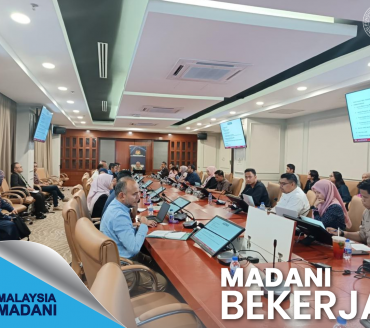Putra Heights explosion: blame the silly soil – Andrew Sia
- Admin UKK
- Berita
Veteran journalist writes that one of Malaysia’s biggest industrial disasters may be heading the way of 1MDB — with zero human fault and plenty of unanswered questions
SO, the Putra Heights gas pipe explosion was due to an “Act of God”, sorry, I mean an “Act of Soil”.
No politicians or developers were at fault, even though there was digging work for a construction project near the pipe.
Selangor Menteri Besar Amirudin Shari revealed on June 30 that soil subsidence had happened since the Petronas gas pipeline was laid in 2000, causing it to sink by 15.9cm.
This damaged the pipe leading to the gas leak and fire. So was the MB indirectly pointing the finger at Petronas for not maintaining the pipe properly in those 25 years?
Yet Selangor police chief Hussein Omar Khan declared there was no negligence, no sabotage and no mischief. Did that clear Petronas?
So, we have yet another mysterious Malaysian disaster with ZERO human involvement.. Let’s all blame the silent soil that can’t speak!
I read many funny and sarcastic comments online about the “real cause” of the tragedy. Here are some:
“Maybe the earthworms wrongly hit the gas pipe.”
“Bring the soil to court!!”
“Even the foreign grass cutters would have noticed if the soil was sinking.”
Only in Malaysia.
- Floods – blame too much rain.
- Landslides – blame rain and weak soil.
- Gas pipe explosion – blame the soil!
1MDB repeated?
It’s like 1MDB all over again — a great crime with “no criminals”, as local authorities initially proclaimed.
And now we have Malaysia’s biggest industrial disaster – with no human fault.
The only difference is that this is happening under a Madani, not Barisan Nasional government.
On April 1, the fire from the Petronas gas pipeline saw flames shooting over 30m into the air, with temperatures reaching 1,000 degrees Celsius.
The surroundings became a hellfire landscape with 162 houses severely or partially damaged.
So who is going to compensate residents for the damage and hardship? The soil?
The Department of Occupational Safety and Health Department (DOSH) said the gas pipe met technical specifications but was not fully supported by the soil around it. This caused a weakness in the welded joint which then broke apart.
The Minerals and Geosciences Department had also found that the pipe was located in “waterlogged soil” which became loose, causing the pipe to sink.
But something doesn’t smell right. Even if soil is waterlogged, why would it move when it’s not on a slope but deep underground? No landslides or sinking land was reported there.
I’m sorry to say this, but blaming “water in soil” is like saying “heavy rain from the heavens” caused the explosion.
This sounds like the ”Act of God” excuse that the late Samy Vellu used when there were disasters.
The DOSH finding is very alarming because Petronas has 2,623km of gas pipelines supplying power and petrochemical plants plus other factories across Peninsular Malaysia.
Since our country has heavy rains, how many pipes are in “waterlogged” soil?
The Cilisos portal traced Petronas gas pipes online and the map shows that they pass areas of coastal Selangor that were once peat swamps, now drained for padi fields. These soils become “waterlogged” in downpours.
Cilisos also found many housing areas next to gas pipes – some without the required 30m “buffer zone”.
Does Petronas need to stop transporting gas until every inch of pipeline is inspected and certified safe?
Or should all residents living near such pipes sell their homes to avoid getting burnt alive?
Is Petronas guilty?
DAP Puchong MP Yeo Bee Yin now says that Petronas is still liable for the disaster, even though ground instability was found to be ”the cause”.
Yeo, a former oil and gas field engineer, says Petronas is responsible for ensuring its assets are in good condition.
and should compensate those affected by the fire.
But there is one problem here – the Selangor police chief has already announced there was NO negligence, sabotage nor mischief. So how can Petronas be liable?
Yet all these years before the Putra Heights disaster, there have been no explosions on over 2,000km of gas pipes, even though some surely pass through “waterlogged” soil.
According to an expert familiar with pipeline safety, Petronas actually has a decent safety record.
“Gas pipelines are very robust and hard to damage. They have gauges at every junction.”
“If there is a leakage, this will trigger an alarm at the central command centre,” explained the expert.
“The pipe is monitored by Petronas with sound and pressure sensors. But the gas leak and ignition may have happened too fast before action could be taken.”
The shops and excavator
So what could have caused such a sudden gas leak? Shortly after the explosion, many netizens pointed to the building of shop lots near the accident site.
In response, Subang Jaya mayor Amirul Azizan Abd Rahim told The Star that the shop development was legally sanctioned back in 2022.
This included approvals to utilise the Petronas Right-of-Way (ROW) over the pipeline area. The contractor was also on an approved panel said the mayor.
But we may have a “smoking gun” clue to this great mystery, a big metal suspect. This is the infamous excavator at the site.
Menteri Besar Datuk Seri Amirudin Shaari initially said no excavators were found there. But he was forced to U-turn on this, claiming he was “misunderstood”.
He also denied that he was trying to “protect” certain developers.
This was after police chief Hussein confirmed in early April that excavation work for a sewage pipe was done 30m from the site, but said police would need two more weeks to investigate if this had caused the blast.
He promised the public then, “No one will escape, and every party involved will be investigated.”
Yet a few days later on April 7, Hussein was quoted by The Rakyat Post that there was “no need to reveal the contractor’s identity at this stage.”
According to police statements, the contractor “followed all standard operating procedures”, including maintaining the approved 2.1-meter depth limit for the sewage pipe installation.
Yet investigations were ongoing then, so how did the police know that excavation SOP had been followed?
On April 29, Hussein announced that this notorious excavator had been located buried using ground penetrating radar.
And now, three months after the tragedy, when the soil is being blamed, the excavation contractor has STILL not been publicly revealed.
The pipe safety expert commented, “The soil subsided because digging was not supervised properly.”
“The same amount of soil extracted must be replaced with the same amount of soil filled..Otherwise the soil will subside. It’s basic soil mechanics.”
So what’s the conclusion? Unfortunately it’s to blame the stupid soil for not staying still. Blame the wicked water in the soil.
Because humans are beyond blame when it comes to mysterious Malaysian disasters. – July 2, 2025
***Andrew Sia is a veteran journalist with 25 years of experience in the media industry


